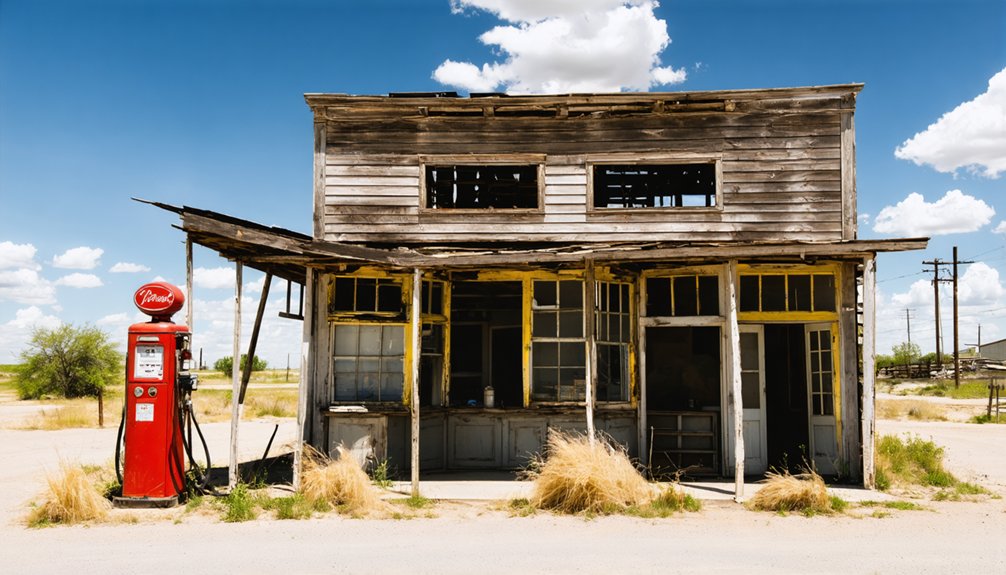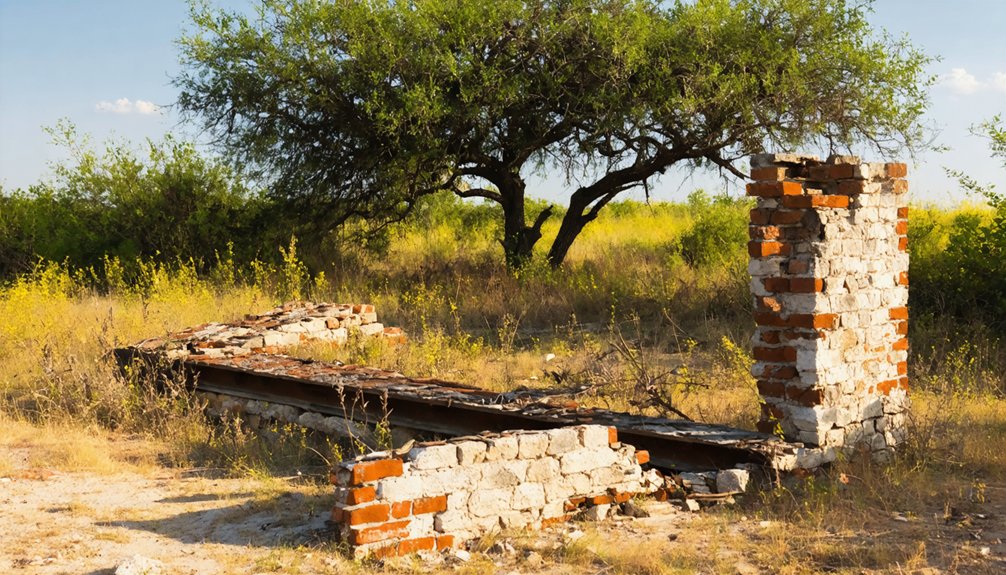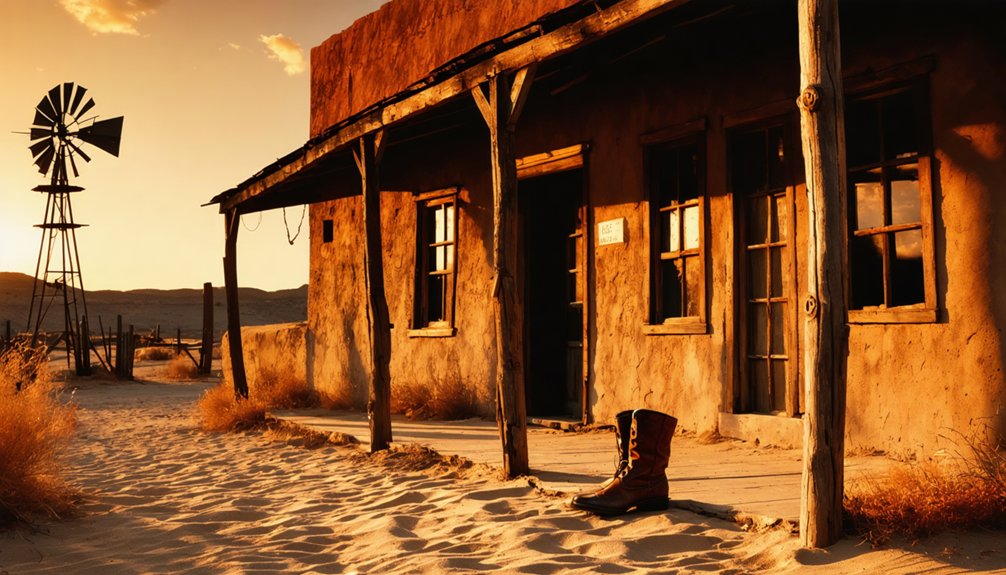You’ll find Sher-Han, a former Phillips Petroleum company town, in Texas’s remote northern panhandle. Established in 1944 during World War II, it housed 400 workers and their families in 105 company-built homes near natural gas processing facilities. The community thrived with amenities like a church, grocery store, and sand-green golf course until the 1960s, when safety concerns prompted its closure. Today, this National Register site stands as a monument to wartime industrial planning and community spirit.
Key Takeaways
- Sher-Han was a company town established in 1944 by Phillips Petroleum Company in Texas’s northern panhandle for gas processing operations.
- The town housed 400 residents in 105 company-built homes with amenities including a grocery store, church, and gas station.
- The community was dismantled in the 1960s due to safety concerns about residential proximity to explosive industrial plants.
- Houses were relocated to neighboring communities rather than abandoned, leaving only empty streets and bare foundations.
- The site is now recognized as a Texas archaeological site and listed on the National Register of Historic Places.
The Birth of a Wartime Industrial Camp
When World War II created an urgent need for domestic energy production in 1944, Phillips Petroleum Company partnered with two pipeline companies to establish Sher-Han, a purpose-built industrial camp in Texas’s remote northern panhandle.
You’ll find this wartime housing settlement’s name cleverly combines references to the Sherman and Hansford processing plants it served. The camp’s strategic location, though initially lacking paved roads, put workers right where they needed to be – next to significant natural gas facilities.
The industrial workforce of roughly 400 people lived in 105 company-built homes, complete with a community center, church, grocery store, and gas station. Due to the remote location, the company offered low rent housing to workers. Workers could enjoy recreational amenities including a sand greens golf course for their leisure time. This self-contained community played an essential role in America’s wartime energy supply, ensuring continuous operation of gas extraction and pipeline facilities critical to both military and domestic needs.
Life in a Company Town
Daily life in Sher-Han revolved around Phillips Petroleum‘s all-encompassing presence, from the modest company-owned homes to the Baptist church that anchored the community’s social calendar.
Phillips Petroleum didn’t just employ the people of Sher-Han – it shaped their entire world, from home life to Sunday worship.
You’d find yourself part of a tight-knit world where community dynamics centered on the local grocery store, gas station, and community center – all owned and operated by the company.
While the remote location might’ve felt isolating, social interactions flourished among the 400 residents who called this industrial camp home. Monthly rental prices varied from $4 to $35 for company housing. The dirt road conditions made winter travel particularly challenging for residents.
You’d gather at the Baptist church for worship and fellowship, shop at the company store for daily necessities, and attend events at the community center.
But this controlled environment came with strings attached – your housing, job, and social life all depended on Phillips Petroleum’s continued goodwill.
Industrial Operations and Economic Impact
You’ll find Sher-Han’s industrial core centered on its natural gas liquids extraction plant, where Phillips Petroleum and other major companies processed gas from the Southern Great Plains oilfield during World War II.
The companies provided extensive benefits to their workers, including company housing, recreational facilities like a sand-greened golf course, and essential services through the company store. When operations declined, homes were relocated to neighboring communities rather than being abandoned.
Your understanding of Sher-Han’s regional impact deepens when you consider how it served as a vital energy hub, providing jobs and spurring economic growth throughout Hansford County during the mid-20th century. The town reached its peak with a population of 400 before being dismantled in the 1960s due to safety concerns.
Gas Processing Operations
Located on the Texas-Oklahoma border, the Sher-Han gas plant has served as an essential natural gas processing hub since its establishment in 1944.
Originally founded by Phillips Petroleum Company during World War II, the facility specialized in gas extraction from southern Great Plains oilfields to support wartime industrial growth.
You’ll find the plant’s capabilities expanded greatly over the decades, with a helium production facility added in 1962 and ethane processing operations in 1978.
The facility connects to the Federal Crude Helium Pipeline through a 37-mile spur, linking it to critical infrastructure like the Exell Helium Plant and Federal Helium Reserve.
The industrial camp reached a population of over 300 residents during its peak operations, with multiple community facilities supporting worker families.
Today, DCP Midstream operates this complex facility, which processes multiple hydrocarbon products while maintaining its role in America’s strategic helium production network. The plant’s strategic location has made it an integral part of Air Products’ operations, with their Panhandle Helium Plant operating adjacent to the facility.
Employment and Worker Benefits
While the gas processing facilities dominated Sher-Han’s industrial landscape, the town’s unique worker benefits and housing programs shaped its identity as a company settlement.
You’d find remarkable worker satisfaction through subsidized housing at just $40 monthly, plus access to modern amenities uncommon in industrial camps of that era. The companies’ commitment to housing stability created a self-contained community where employees could thrive despite the remote location. The town’s focus on wartime industrial development helped establish its comprehensive infrastructure and worker support systems.
- Company-maintained facilities included paved streets, concrete sidewalks, and landscaping that elevated living standards.
- A community center, Baptist church, and grocery store with Phillips 66 gas station met daily needs.
- Recreational amenities like a sand-green golf course provided leisure opportunities for workers and their families.
These benefits helped offset the challenges of working with volatile materials and irregular schedules required by continuous plant operations.
Regional Economic Growth
During its peak operations from 1944 through the 1960s, Sher-Han emerged as an essential economic engine for Hansford County and the broader Texas Panhandle region.
You’ll find that the town’s natural gas processing facilities and pipeline operations drove significant infrastructure investment, establishing critical energy transport networks that connected the southern Great Plains oilfields to national markets.
The presence of industry giants like Phillips Petroleum and Panhandle Eastern created opportunities for economic diversification beyond agriculture. Like the workers in Thurber, employees were paid through a restrictive once-a-month paycheck system.
Through their strategic wartime resource processing and interstate gas transport capabilities, you’d see how Sher-Han’s facilities supported both local employment and regional development.
The town’s economic influence extended well beyond its borders, generating municipal revenues and spurring growth in surrounding communities until safety concerns led to its closure in the 1960s.
Community Facilities and Daily Living

As Phillips Petroleum and its partners developed Sher-Han in the 1950s, they established a self-contained community with amenities that rivaled larger towns of the era.
You’d find everything needed for daily life, from a well-stocked grocery store with a Phillips 66 gas station to a uniquely positioned Baptist church straddling the Texas-Oklahoma border. Community engagement flourished at the community center, while a golf course with sand greens provided leisure opportunities.
Small-town Sher-Han offered everything from groceries to a Baptist church uniquely perched between states, plus recreation for its tight-knit community.
- Monthly rent for company housing was just $40, making it affordable for workers
- The town supported up to 400 residents at its peak, creating strong social impact
- Modern infrastructure included paved streets, concrete sidewalks, and landscaping
Daily life centered around the industrial operations, with most residents working for Phillips Petroleum or its pipeline partners.
The Beginning of the End
By the 1960s, you’d find Sher-Han facing serious safety concerns over its explosive industrial plants situated perilously close to family homes.
You’ll understand why corporate liability risks, combined with newly paved roads connecting to nearby towns, prompted companies to reconsider maintaining a residential workforce next to hazardous operations.
Your perspective of Sher-Han’s decline becomes clearer when you realize that improved transportation allowed workers to commute from safer locations, leading companies to dismantle the community rather than invest in its upkeep.
Safety Concerns Emerge
Once Phillips Petroleum established its natural gas liquids extraction and pipeline operations near Sher-Han in the early 1960s, the town’s fate was sealed.
The proximity of volatile industrial plants to residential areas created significant safety risks that couldn’t be ignored. As safety regulations tightened, Phillips Petroleum had to confront the stark reality of maintaining family homes near explosive materials.
- You’d find yourself isolated during emergencies due to unpaved roads that became impassable in harsh weather.
- Your access to medical and firefighting resources was severely limited by the remote location.
- Your family’s safety was constantly at risk from potential industrial hazards involving explosive materials.
The combination of these dangers ultimately forced corporate decision-makers to relocate residents away from the hazardous operations, marking the beginning of Sher-Han’s decline.
Relocation Takes Hold
When Phillips Petroleum started issuing relocation notices in the early 1960s, you’d have witnessed an unusual exodus from Sher-Han. Unlike typical ghost towns where buildings slowly decay, residents purchased their homes at bargain prices and physically moved them to nearby communities, particularly Guymon, Oklahoma, about 15 miles away.
The relocation challenges weren’t insurmountable, thanks to newly paved highways that made daily commuting feasible.
You can still see evidence of the community dispersal today – empty streets, curbless sidewalks, and bare foundations mark where this company town once thrived. While the gas plant continued operations, the social fabric of Sher-Han unraveled as its 400 residents scattered to neighboring towns.
The transformed landscape stands as a reflection of mid-century industrial planning and corporate liability concerns.
What Remains Today

Although Sher-Han once bustled with industrial activity, today’s visitors will find only scattered remnants of this former Phillips Petroleum company town.
From Texas State Road 9, you’ll glimpse foundations of former homes, deteriorating barns, and bunkhouses amid the persistent landscaping that’s survived decades of abandonment.
While the Baptist church and most houses were relocated in the 1960s, the site’s planned industrial heritage remains visible through its:
- Paved streets, concrete sidewalks, and curbs that outline the original town layout
- Surviving trees, shrubs, and flowers that still grace the ghost town’s grounds
- Visible building foundations that hint at the town’s former residential footprint
You can’t access the site directly, but its remote location near the Oklahoma border offers a haunting glimpse into Texas’s industrial past.
Legacy in Texas Panhandle History
Established during World War II’s critical push for energy resources, Sher-Han emerged as a pivotal player in the Texas Panhandle’s natural gas industry.
You’ll find its legacy woven into the region’s cultural heritage, from the innovative industrial-residential planning that created a thriving community to the economic ripples that strengthened nearby towns.
Though the town’s life was relatively brief, its impact on Texas’s energy sector development can’t be understated.
The town’s recognition as both a Texas archaeological site and its placement on the National Register of Historic Places underscores its significance.
Today, Sher-Han stands as a symbol of historical preservation efforts, reminding you of an era when industrial needs and community life merged successfully in the Texas Panhandle.
Frequently Asked Questions
Were There Any Major Industrial Accidents During Sher-Han’s Operational Years?
You won’t find any documented major industrial accidents during operations. Despite inherent risks in gas processing, there aren’t any accident reports showing safety incidents during the town’s active industrial years.
What Happened to the Original Residents After Leaving Sher-Han?
You’ll find many moved to Guymon, commuted to nearby oilfields, or relocated their homes entirely. The residential migration scattered close-knit neighbors, but some maintained ties despite the community impact.
Did Any Famous People or Notable Figures Live in Sher-Han?
You won’t find any famous residents or notable visitors documented in Sher-Han’s history, though Benny Wilson, who grew up there while his father worked at the Mich-Wish plant, is remembered locally.
How Did Children Receive Their Education in This Remote Town?
Against all odds, you’d find children getting their education through remote schooling at home, with community teachers stepping in, while some families made long treks to nearby towns after roads improved.
What Was the Average Salary of Workers at Sher-Han’s Facilities?
You’d have found facility workers earning between $2,500-$5,000 annually, with skilled operators commanding higher average wages. Your company housing costs of $40 monthly helped stretch those mid-century paychecks further.
References
- https://en.wikipedia.org/wiki/Sher-Han
- https://texascooppower.com/old-haunts/
- https://www.ghosttowns.com/states/tx/sher-han.html
- https://discovertexasoutdoors.com/places/sher-han-texas-a-vanished-gas-camp-with-moved-homes-and-lost-streets/
- https://mix941kmxj.com/ghost-towns-from-our-area-that-are-worth-a-weekend-road-trip/
- https://www.ghosttowns.com/states/tx/tx_ghst_twns_sect1345.doc
- https://en.wikipedia.org/wiki/List_of_ghost_towns_in_Texas
- https://texascooppower.com/tcp-talk-december2013/
- https://mix941kmxj.com/how-a-texas-industrial-camp-went-from-boom-town-to-ghost-town/
- https://www.tshaonline.org/handbook/entries/world-war-ii-internment-camps



